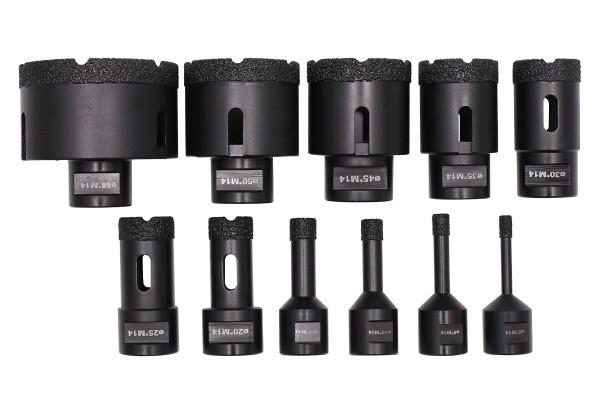
How to use diamond drill bits?
Diamond drill bits are essential tools for precision drilling in a variety of materials, including concrete, ceramics, and stone. To maximize their effectiveness and ensure safe operation, it is important to follow specific guidelines when using these drill bits. This article will outline the key steps in using diamond drill bits and the characteristics of them.
Understand the Basic Structure of Diamond Drill Bits
1. Drill body
The drill body is the basic component of a diamond drill bit and is usually made of high-quality steel. The choice of this material is critical as it provides the necessary strength and durability to withstand the rigors of drilling holes in hard substrates. The drill body is designed to support the diamond tip and facilitate the transfer of rotational energy from the drill to the cutting edge. Its sturdy construction ensures that the drill bit can withstand high levels of stress and wear during operation.
2. Diamond Section
The cutting edge of a diamond drill bit is equipped with a diamond tip, which is the key to its cutting efficiency. These segments can be made from synthetic single crystal diamond or polycrystalline diamond.
3. Welding materials
The welding material plays a vital role in fixing the diamond tip to the drill body. Commonly used welding materials include copper alloy, silver, nickel, etc. The welding process ensures that the diamond tip is firmly attached to the drill body, enabling efficient energy transfer during the drilling process.
Copper Alloy: Copper alloys are known for their excellent thermal conductivity and are often used in applications where heat dissipation is critical. It helps keep the drill bit cool during operation, reducing the risk of overheating and extending the life of the diamond bit.
Silver and Nickel: These materials are also used for their strong bonding properties and wear resistance. They provide a strong connection to the diamond bits, ensuring they stay in place during the drilling process.
The basic structure of a diamond drill bit includes the drill body, diamond tip, and welding material, designed to optimize performance and durability in challenging drilling applications. Understanding these components is critical to selecting the right diamond drill bit for a specific task, ensuring the efficiency and effectiveness of your drilling operation.
Features of Diamond Drill Bits: Efficiency, Versatility and Durability

1. Fast drilling speed and high efficiency
One of the outstanding features of diamond drill bits is their ability to drill holes quickly while maintaining high efficiency. Unlike traditional drill bits, which may struggle with harder materials, diamond drill bits are designed to cut through hard substrates with ease. The sharpness and hardness of the diamond tips allow for fast penetration, reducing the time required for drilling tasks. This efficiency not only increases productivity but also minimizes wear on the drill bit, making it a cost-effective solution for a variety of applications.
2. Versatility of different materials
There are many types of diamond drill bits, each tailored to the specific material. This versatility is one of their greatest strengths. Whether you're drilling through soft rock, hard rock, concrete, or ceramics, there's a diamond drill bit designed specifically for the job.
Soft Rock: For softer materials, specialized diamond drill bits can handle the drilling process efficiently without excessive wear.
Hard Rock: In contrast, diamond drill bits designed for hard rock have strong diamond tips that can withstand the rigors of drilling into hard surfaces.
Concrete & Ceramics: Diamond drill bits also effectively drill into concrete and ceramics, providing clean, precise holes without chipping or cracking the material.
This adaptability makes diamond drill bits an essential tool for professionals in a variety of industries, ensuring they can handle a variety of drilling challenges.
3. Unique manufacturing process, long service life
The manufacturing process of a diamond drill bit is a key factor in its performance and durability. These drill bits are produced using advanced technology that increases their hardness and reduces wear. Using high-quality diamonds ensures that cutting edges remain sharp and effective over the long term.
High hardness: The hardness of diamond allows these drill bits to maintain their cutting ability even when used on the hardest materials, resulting in fewer replacements and lower overall costs.
Low wear: Diamond’s unique properties also help reduce wear rates, meaning diamond drill bits can be used for extended periods of time without significant loss of performance.
Long Lifespan: Due to their high hardness and low wear, diamond drill bits last longer than traditional drill bits, making them a solid investment for professionals.
How to Use Diamond Drill Bits: A Comprehensive Guide
1. Drill bit selection
Choosing the right diamond drill bit is the first step to successful drilling. Here are the key factors to consider:
Material compatibility: Choose a diamond drill bit model designed specifically for the material you want to drill. Different materials require different types of diamond drill bits for the best results. For example, a drill bit designed for concrete may not perform well on ceramic, and vice versa.
Core length: The core length of a drill bit is important, especially when you need to drill deep holes. Make sure the core length is appropriate for the depth of the hole you plan to create.
Drill bit diameter: The diameter of the drill bit should match the size of the hole you need. Consider the specifications of your project to determine the appropriate diameter.
Drill body length: The overall length of the drill body should also be considered. For deeper drilling applications, a longer drill body may be required, while for shallower holes, a shorter drill body may be sufficient.
2. Preparation before use
Check drill bit: Before installation, carefully inspect the drill bit for any signs of damage or wear. Make sure the diamond bit is intact and there are no cracks or chips in the drill bit. Using a damaged drill bit can result in reduced performance and safety hazards.
Safe install: Use appropriate clamps to secure the drill bit securely to the drill rig. Make sure it is tight to prevent any movement during operation that could affect accuracy and safety.
Read instructions: Familiarize yourself with the manufacturer's instructions and precautions for the specific diamond drill bit you are using. Each drill bit may have unique requirements or recommendations that are important for safe operation.
Set up the drill: Ensure the drill is set up and calibrated correctly for the specific drilling task. Check that all components are working properly and safety features are in place.
3. Drilling operations
Gradually speed up:
Before starting the drilling process, first drill the hole at medium or slow speed. This initial stage allows the drill bit to engage the material without excessive force.
Gradually increase the speed until you reach the maximum recommended speed for your specific drill bit and material. This method helps prevent overheating and ensures a smoother drilling experience.
Initial "knock": To increase operating efficiency, it is beneficial to "knock" the drill bit into the material for a few seconds before the drill bit is fully engaged. This technique helps create a small indentation that allows the drill to start cutting more efficiently.
Avoid excessive swing: When drilling, it is important to maintain a steady and controlled movement. Avoid excessive oscillation of the drill bit or application of lateral force as this may result in damage to the drill bit or workpiece. Stable drilling positions ensure precision and reduce the risk of breakage.
Cutting Lubrication: During drilling, cutting lubrication is applied depending on the hardness of the material and the depth of the hole. Proper lubrication helps dissipate heat, reduce friction, and extend the life of your drill bit. Different materials may require different types of lubricants, so be sure to choose the right lubricant for your specific application.
4. Maintenance after use
Clean the drill bit: The drill bit must be wiped clean immediately after drilling. After the machine has stopped, remove any debris or residue from the surface of the drill bit. This practice helps maintain the integrity of the diamond segments and prevents buildup that could affect future performance.
Correct storage:
Store drill bits in a dry environment away from direct sunlight. Exposure to moisture and UV rays can cause material degradation and shorten the life of the drill bit.
In addition, it is recommended to spray a layer of anti-rust agent on the surface of the drill bit before storage. This protective coating helps prevent rust and corrosion, ensuring your drill remains in top condition for the next time you use it.
Frequently Asked Questions (FAQ) about diamond drill bits
1. What is the service life of a diamond drill bit?
Answer:
The life of a diamond drill bit can vary greatly depending on a number of factors, including operating pressure, the hardness of the material being drilled, and the conditions under which the drill bit is used. Generally speaking, a well-maintained diamond drill bit will last hundreds of hours. Proper use, including proper speed, lubrication, and avoiding excessive force, can extend the life of your drill bit. Regular inspections for wear and damage are also critical to determining when drill bits need to be replaced.
2. Why is the cutting flow large when drilling concrete?
Answer:
When drilling concrete, the cutting flow rate is often higher due to the hardness of the material. Concrete creates a lot of friction during cutting, so increased lubrication is needed to keep the drill bit cool and reduce wear. The high cutting flow rate helps to effectively remove debris and dust generated during the drilling process, ensuring that the diamond tip maintains its cutting effect. Adequate lubrication is essential to prevent overheating and extend the life of the drill bit.
3. How to judge whether the drill bit needs to be replaced?
Answer:
Determining when to replace a diamond drill bit requires monitoring its cutting efficiency and physical condition. If you notice a significant decrease in cutting performance, such as slower drilling speed or increased resistance, it may be time to consider replacement. Also, inspect the drill bit for any obvious signs of damage or wear, such as broken or missing diamond discs. If a drill bit shows signs of excessive wear or damage, it must be replaced immediately to maintain drilling efficiency and prevent further complications during the operation.
Conclusion
Through the introduction of the basic structure and usage of diamond drill bits, we can see that diamond drill bits have great advantages over traditional drill bits in terms of speed, efficiency, precision, etc. However, if they are used improperly or poorly maintained, their service life and effectiveness will also be affected. Therefore, before using a diamond drill bit, you should carefully read its instructions and precautions and operate it according to the requirements.
-
Online service
-
Official wechat
account
-
QQ:40933769
-
E-mail:
sales@z-lion.com
Online service
Please feel free to give your inquiry in the form below. We will reply you in 24 hours.

